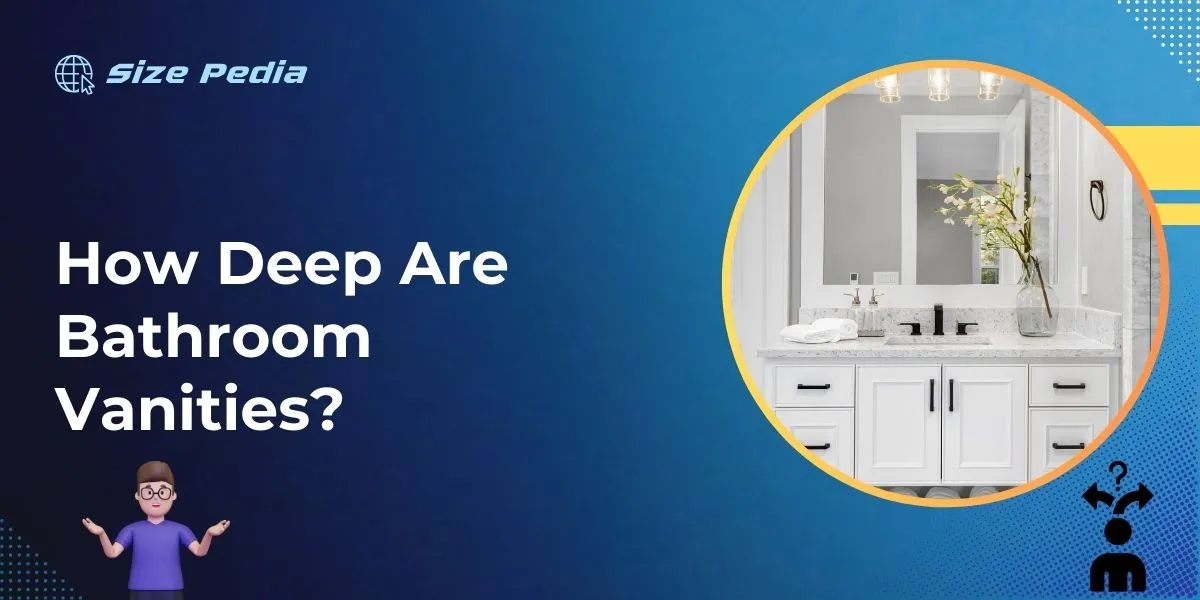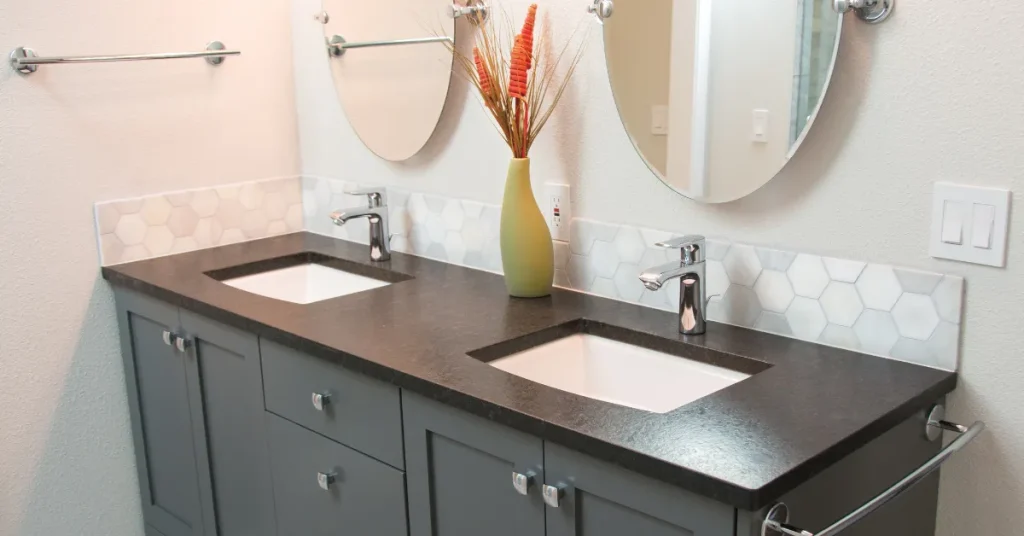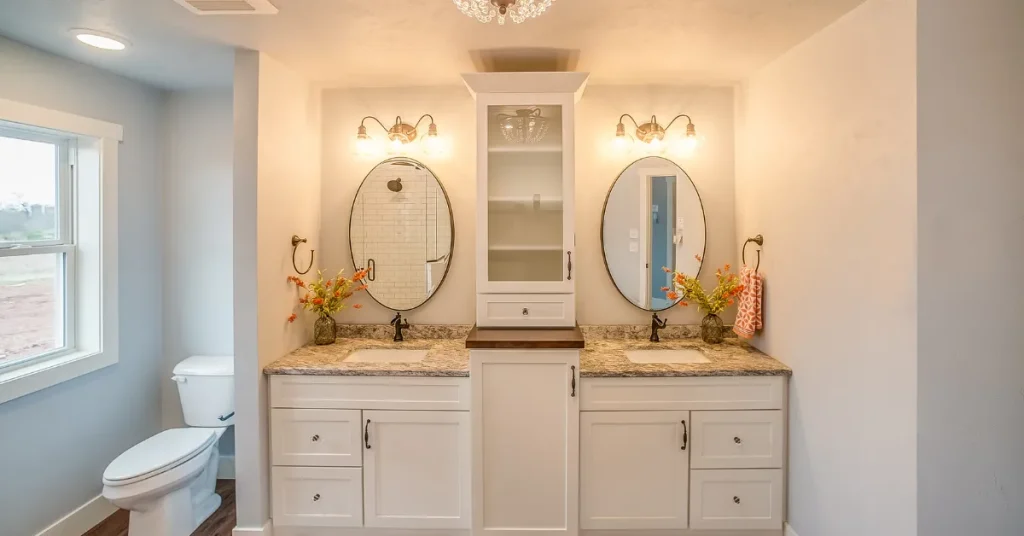Standard bathroom vanities are typically 21 inches deep. This measurement can vary, with some models being 17 to 24 inches deep.
Selecting the right bathroom vanity for your space involves balancing style, function, and the layout of your bathroom.
A vanity too deep can hinder movement, especially in smaller bathrooms, while one too shallow may not provide enough storage or counter space.
The depth of the vanity also affects how much of the bathroom’s floor space is utilized and can impact the room’s overall aesthetic and functionality.
When choosing a vanity, it’s essential to consider the size of the bathroom, the desired storage needs, and the vanity’s proportions in relation to other fixtures.
Proper vanity depth ensures comfort, accessibility, and maximizes the efficiency of your bathroom space.

Standard Vanity Depths
When picking out a new bathroom vanity, size matters. The depth of your vanity can influence both the function and comfort of your bathroom. Let’s dive into what depths are standard and what will fit best in your space.
Minimum Depth For Functionality
Bathroom vanities need to balance space-saving with usability. The minimum depth for a functional vanity is generally accepted to be around 17 to 20 inches.
This size is tight but works in narrow bathrooms. It allows enough room for basic bathroom activities like washing hands and brushing teeth.
Popular Dimensions For Comfort
Bathroom vanities typically come in a few depth sizes that are known for comfort. The most common depth is 21 inches, providing ample space for more bathroom tasks.
People often prefer vanities with this depth as it offers good functionality without taking up too much floor space. For families or those looking for a bit more luxury, 24 inches deep is also a popular choice, allowing for additional storage and countertop space.
| Depth (in inches) | Comfort Level |
| Less than 17 | Too Narrow |
| 17 – 20 | Functional Minimum |
| 21 – 24+ | Comfortable for Most |
The chart above highlights the spread of vanity depths and how they correlate to the comfort level of the user.
Factors Affecting Vanity Depth
When choosing a bathroom vanity, depth plays a crucial role. It affects both the bathroom’s functionality and style.
Different factors shape the depth needed for your space. Understanding these can lead to a perfect fit for your bathroom. Let’s explore these elements.
Bathroom Layout Constraints
Space is a key driver in deciding how deep your vanity can be. Here’s what to consider:
- Room size: Smaller bathrooms require more compact vanities.
- Traffic flow: A deeper vanity shouldn’t block movement.
- Door openings: Ensure doors have enough space to swing open.
A professional measurement ensures the vanity suits the layout.
| Room Size | Suggested Vanity Depth |
| Small | 14-18 inches |
| Medium | 20-22 inches |
| Large | 24+ inches |
Sink Style And Size
The chosen sink impacts the vanity depth. Here are the main styles:
- Top-mount: Sits above the counter and may require less depth.
- Undermount: Sits under the counter, allowing for a sleek look.
- Vessel: Sits on top, often allowing for narrower vanities.
- Integrated: Blends with the vanity top, requiring specific depths.
Always match the sink’s size with the vanity’s space to maintain balance and functionality.
Maximizing Small Bathroom Spaces

Bathroom vanities come in various sizes. Yet in a tight area, each inch matters. A smart vanity choice can create the illusion of a larger bathroom. Let’s dive into how to choose the perfect vanity and design a space-saving bathroom without sacrificing style or functionality.
Choosing A Shallower Vanity
Standard vanities might be too deep for small bathrooms. A shallower vanity increases floor space, making the room feel open.
- Look for vanities under 20 inches deep.
- They’re perfect for narrow spaces.
- Pick a model with a sink that doesn’t protrude.
Ensure the vanity still meets storage needs. Wall-mounted or pedestal styles can be ideal, blending function with space efficiency.
Space-saving Design Tips
Design plays a key role in maximizing a small bathroom’s space. Clever storage and visual tricks can make a big difference.
| Tips | Benefits |
| Use light colors | They make spaces appear larger. |
| Install mirrors | Mirrors create depth and light reflection. |
| Floating shelves | They offer storage without clutter. |
| Towel racks over the door | They save wall space and keep towels handy. |
By applying these tips, even the smallest bathrooms can look spacious and inviting.
Deep Vanities For Spacious Bathrooms
Bathroom vanities with extra depth transform a spacious bathroom. A deep vanity provides more countertop and storage space. Say goodbye to cluttered surfaces and crammed drawers.
Choose a vanity deeper than the standard 21 inches and unlock the full potential of your bathroom.
Benefits Of Extra Counter Space
More room to spread out means you can keep all your toiletries within reach. Imagine starting your day in a space that’s organized and clutter-free. Here are the benefits you’ll enjoy with more counter space:
- Room for multiple users: Families can get ready together with ease.
- Space for appliances: Keep hairdryers, straighteners, and more at hand.
- Fewer spills and stains on surfaces: A larger countertop catches more drips.
Incorporating Larger Storage Solutions
A deeper vanity offers substantial benefits in storage too. Larger drawers and more shelving mean each item has a place. Let’s look at what larger storage solutions can offer:
| Feature | Benefit |
| Deep drawers | Store bulkier items neatly away. |
| Tall cabinets | Maximize vertical space for linens and tall bottles. |
| Under-sink storage | Perfect for hiding cleaning supplies. |
Custom Vanity Solutions
Exploring the world of custom bathroom vanities opens up a new dimension of personalization within your bathroom. Here, the standard depth of 21 inches no longer confines you. Embrace the freedom to craft a piece that fits your space and style perfectly.
Tailoring Depth To Your Needs
Finding the perfect vanity depth is like fitting a puzzle piece into your bathroom space. You might want a slim vanity for a tight area, or perhaps a deeper countertop to accommodate more items. The choice is yours, and the customization options are limitless.
- Save Space: Opt for a vanity less than 21 inches deep.
- Maximize Storage: Choose a model that extends beyond the usual depth.
- Accessibility: Consider the reach of all users to ensure ease of use.
Working With A Cabinetmaker
Collaboration with a skilled cabinetmaker can turn your vision into reality. These experts marry function with aesthetics, assuring your custom vanity not only looks good but holds up to daily use.
| Steps to Working with a Cabinetmaker |
| 1. Share your design ideas and requirements. |
| 2. Review and refine preliminary sketches. |
| 3. Pick materials that will endure moisture and wear. |
| 4. Approve final designs and commence the build. |
Each piece crafted with a cabinetmaker stands the test of time and injects your personality into the bathroom space.
Installation And Plumbing Considerations

Turning the space into an oasis begins with the right bathroom vanity. Yet, understanding the installation and plumbing considerations is key to a seamless setup.
Here, we’ll dive into specifics to ensure a vanity not only fits but also functions flawlessly.
Ensuring Access To Utilities
Prior to installation, confirm the placement of your utilities. This step is crucial. Here’s what you need to check:
- Water supply lines must be within reach.
- Drainage systems should align with the vanity’s structure.
- Electrical outlets need to be safely accessible.
Measure these points against the vanity’s blueprint. Ensure no clashes disrupt functionality.
Adjusting For Vanity Depth
Vanity depth greatly influences the installation process. Consider:
- Deeper vanities may require additional plumbing adjustments.
- Extended pipes or hoses might be necessary to bridge gaps.
- Ensure doors or drawers open without hitting fixtures.
Adjustments ensure a perfect fit and prevent future hassles. A balance of aesthetics and practicality is vital for long-term satisfaction.
| Vanity Depth | Plumbing Change |
| Less than 18 inches | Minor or no change needed |
| 18 to 24 inches | Standard adjustments |
| More than 24 inches | Significant changes required |
FAQs About How Deep Are Bathroom Vanities
What Is The Standard Depth Of Bathroom Vanities?
Standard bathroom vanities typically measure between 17 to 24 inches in depth. However, the average depth is often 21 inches. This allows enough space for most sinks and fixtures while providing ample room for movement in the bathroom.
Can Bathroom Vanities Be Customized In Depth?
Yes, bathroom vanities can be customized to fit various depths. Many manufacturers offer custom services, allowing you to specify the depth that works best for your space and needs. Custom vanities are great for bathrooms with non-standard layouts.
Does Vanity Depth Include Sink Overhang?
The listed depth of a vanity usually does not account for any sink overhang. Overhang can add an extra half-inch to an inch depending on the sink style. Always measure the total space to ensure the vanity and sink will fit comfortably.
Do Deeper Vanities Offer More Storage?
Deeper vanities often do provide more storage space. With additional depth, drawers and cabinets can hold larger items, making them ideal for family bathrooms or those requiring extra storage. However, they do require more floor space.
Conclusion
Wrapping up, selecting the right vanity depth hinges on your bathroom’s layout and your needs. Common measurements span from 17 to 24 inches.
Prioritize comfort and functionality for a seamless daily routine. Remember, the perfect fit enhances both aesthetics and practicality in your personal space.
Choose wisely for a harmonious bathroom design.
Resources:
1. https://www.access-board.gov/files/ada/guides/lavs-sinks.pdf
